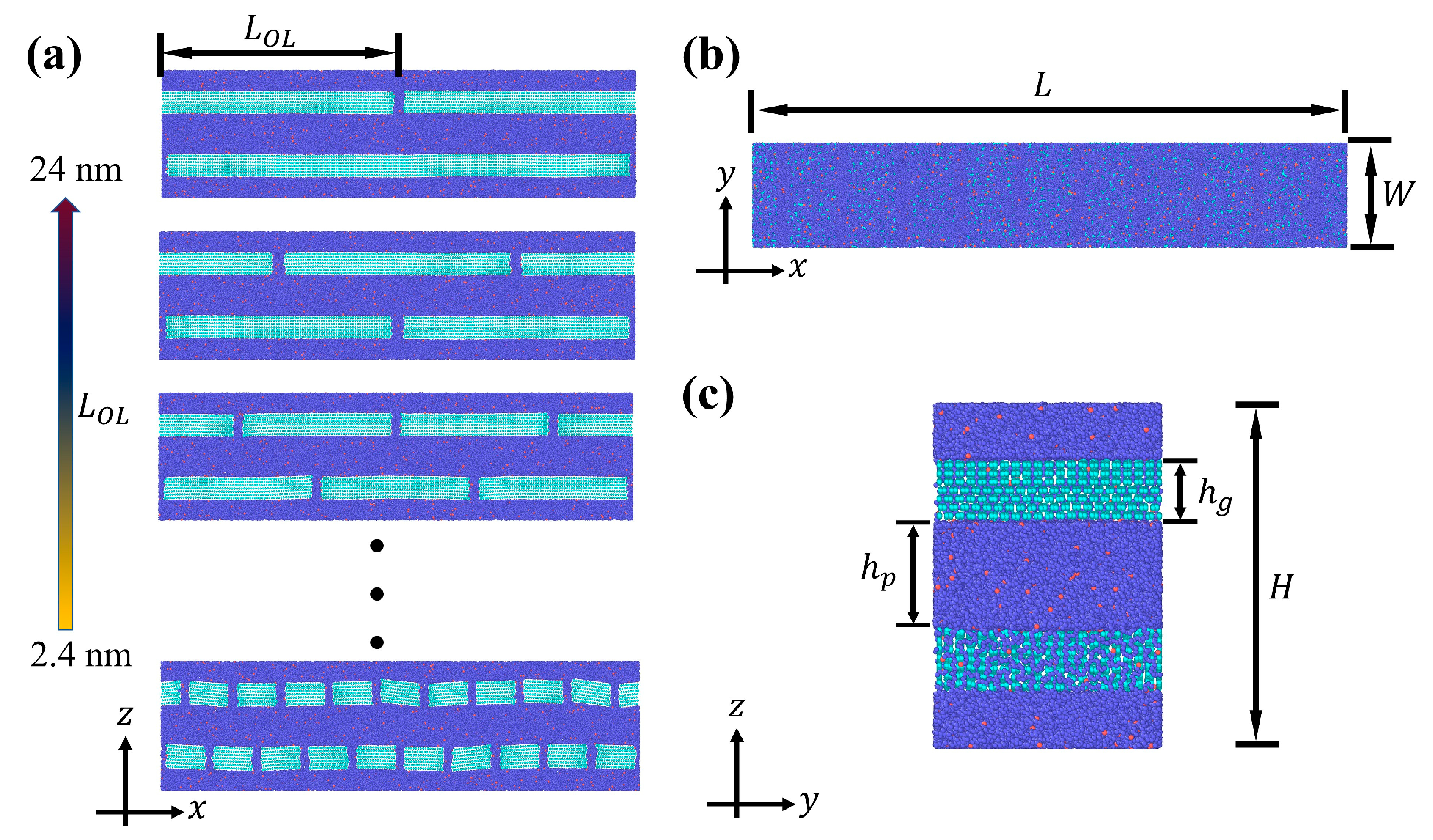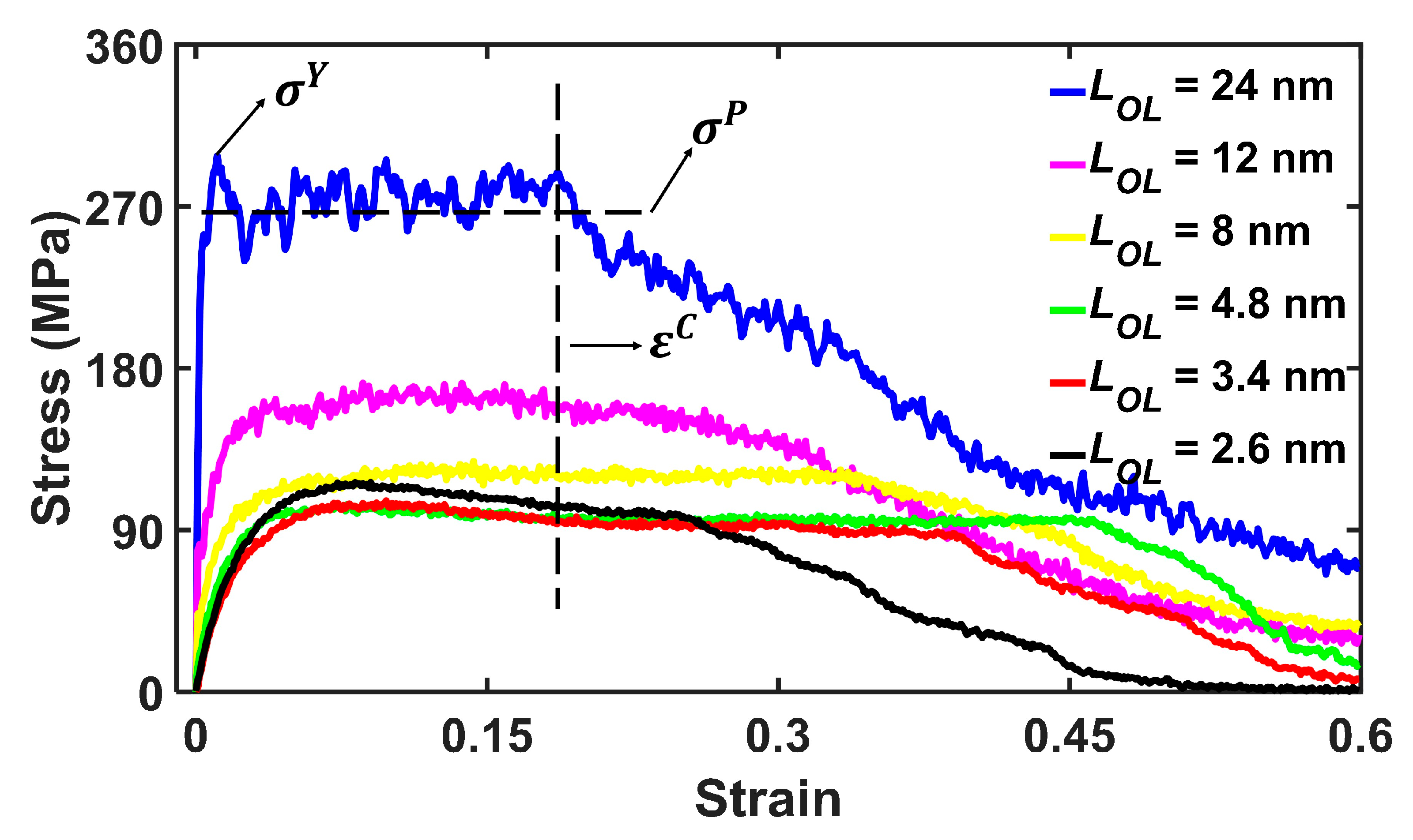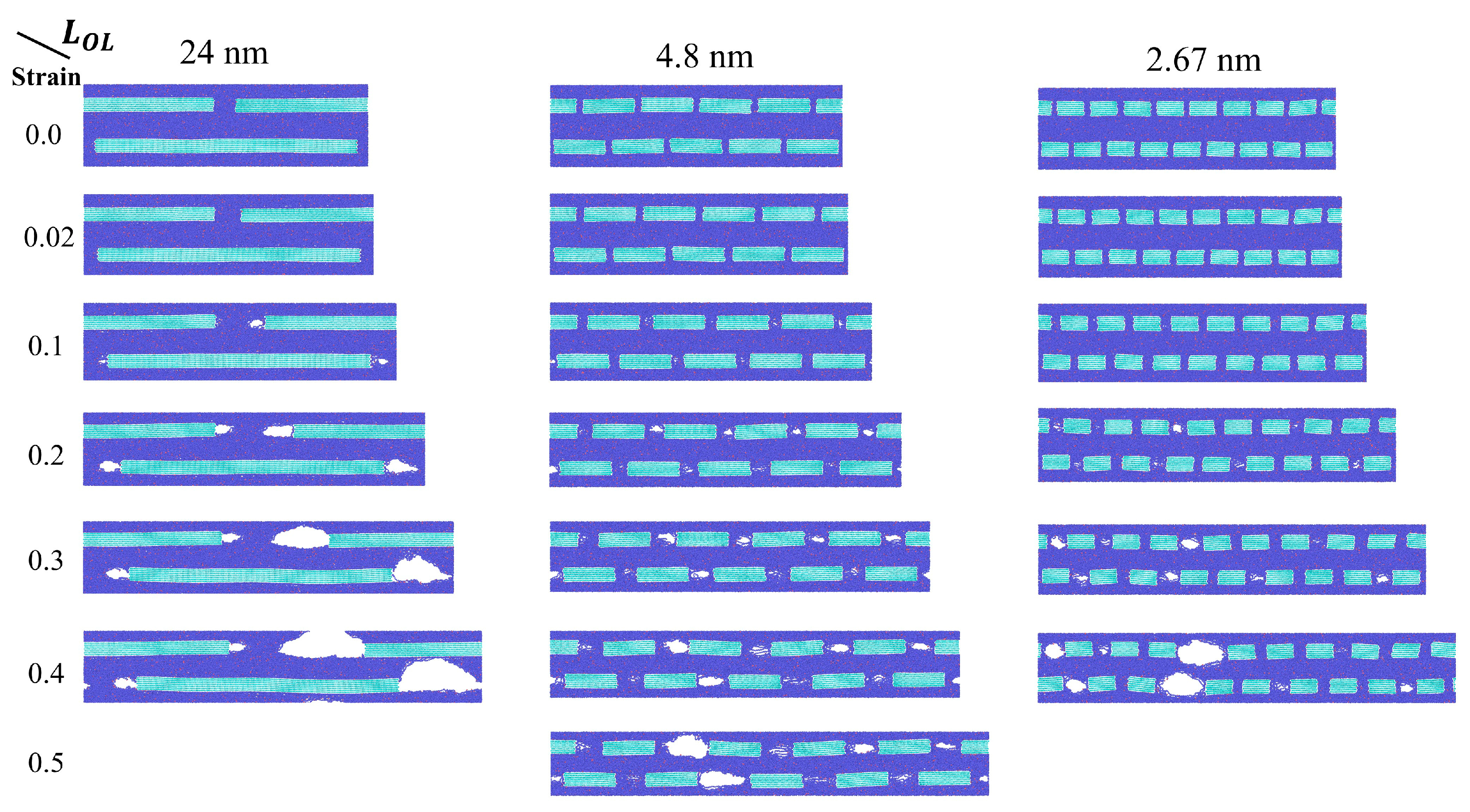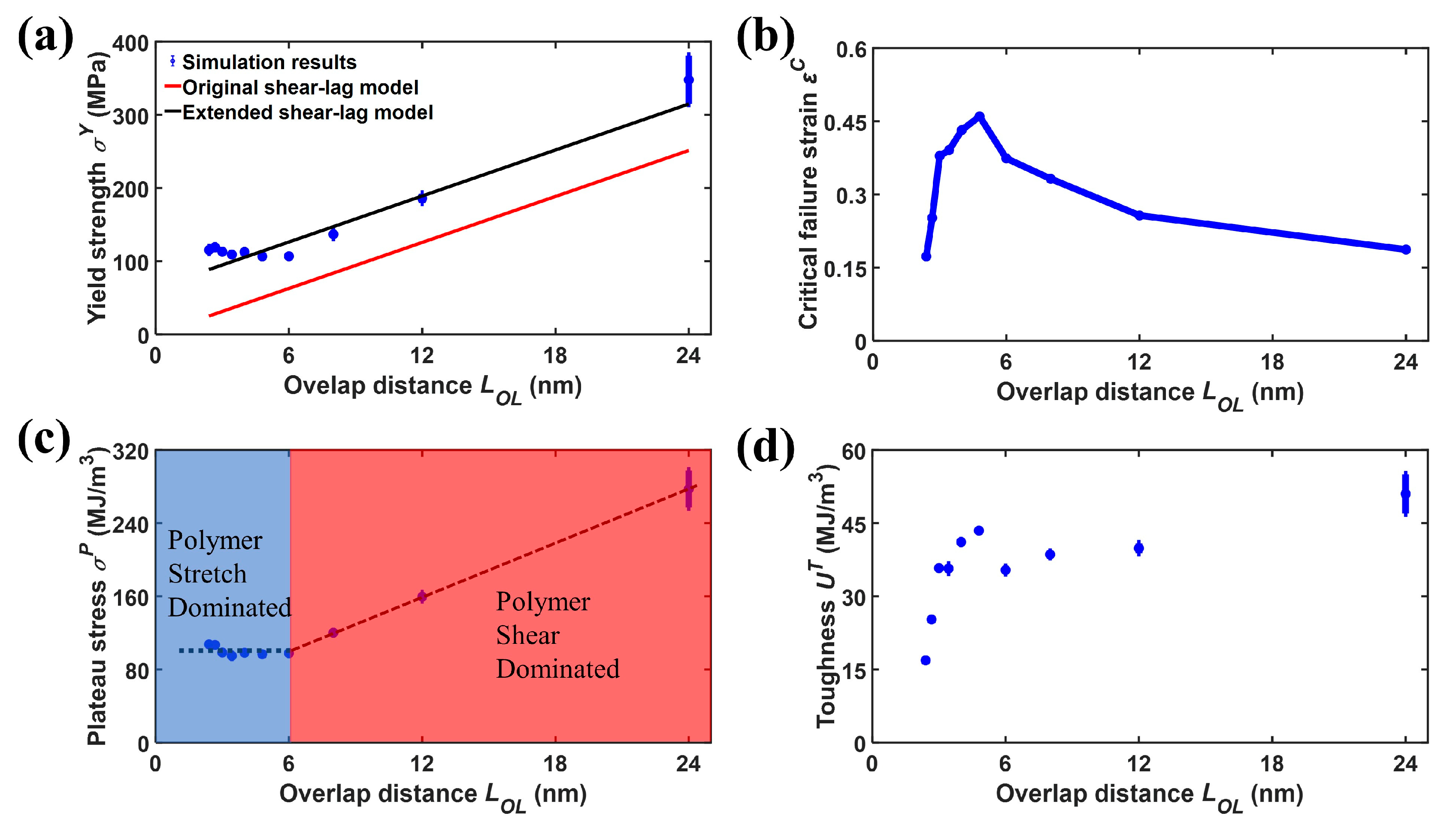1. Introduction
Nacre, a natural “brick-mortar”-structured nanocomposite, achieves an extraordinary combination of strength and toughness that is rarely attained in artificial materials [
1]. Its structure consists of approximately 95% aragonite platelets and 5% organic biopolymer. Notably, nacre exhibits a fracture toughness of about 10 MPa·m
1/2—two orders of magnitude higher than that of monolithic aragonite (0.25 MPa·m
1/2)—while retaining a substantial strength of 80 MPa compared to 160 MPa for pure aragonite [
2]. This enhancement is largely due to efficient stress transfer across the interface, mediated by the nanoconfinement of the polymer adhesive between mineral platelets. The extreme dimensional constraints—~500 nm for aragonite and ~10 nm for the biopolymer layer [
3]—promote the formation of a distinct interphase, where the deformation behavior of the polymer is critical to mechanical performance [
4]. In particular, under stress, the confined polymer undergoes competing modes of deformation: polymer stretching and polymer shear, both essential for toughness and strength. Inspired by nacre, graphene–polyethylene nanocomposites have been developed with similarly promising properties [
5,
6,
7,
8,
9]. However, the detailed mechanisms behind strength and toughness—especially the role of the overlap distance between reinforcing sheets in modulating polymer stretch versus shear—remain unclear. Current designs often rely on empirical approaches rather than mechanistic insight. Understanding how interfacial architecture influences nanoconfined polymer behavior, particularly the competition between these two deformation modes, is crucial for the rational design of high-performance bio-inspired nanocomposites.
The high strength and toughness of nacre and nacre-inspired “brick-mortar” nanocomposites originate from a variety of interfacial interactions at the nanoscale. A significant enhancement in interface strength contributes to improved load transfer and consequently superior mechanical performance. These strengthening mechanisms arise from robust interfacial interactions, typically classified as either non-covalent or covalent bonds [
10]. Non-covalent interactions—such as hydrogen bonding [
5,
11], ionic bonds [
12,
13,
14], and van der Waals forces [
15,
16]—are prevalent in natural nacre and widely incorporated into bio-inspired materials. Graphene, known for its high specific surface area and exceptional in-plane stiffness (approximately 1 TPa) [
17], is particularly suitable for designing such composites. The extensive interface area and strong interfacial interactions between graphene and polymer matrices induce a nanoconfinement effect, which substantially enhances mechanical properties, including toughness and strength. Surface modification further introduces functional groups to graphene, promoting stronger interfaces and facilitating the fabrication of high-performance “brick-mortar” nanocomposites. In these materials, interfacial sliding between adjacent bricks, mediated by reversible non-covalent bonds, results in ductile deformation and high toughness [
18,
19,
20]. For example, Zhang et al. fabricated “brick-mortar” composites using monolayer oxidized graphene and ultrathin polymer layers, demonstrating that hydrogen and van der Waals interfacial interactions significantly enhance crack bridging [
20]. He et al. employed melamine cross-linkers to develop an optimization strategy for graphene-oxide composites, simultaneously increasing strength and toughness through non-covalent interface engineering [
19]. Similarly, Jia et al. introduced a self-folding graphene design that improves ductility with minimal strength reduction, utilizing energy dissipation via the ductile failure of van der Waals interfaces [
21]. In summary, non-covalent nacre-inspired “brick-mortar” nanocomposites are capable of breaking and reforming the non-covalent interfacial interactions, maintaining interfacial shear stress and energy dissipation efficiency, and thus the strength–toughness paradox can be potentially solved accordingly. Therefore, in this paper, the influences of non-valent interfacial interactions will be investigated on the strength and toughness of nacre-inspired nanocomposites.
While the role of interfacial interactions in enhancing the mechanical properties of “brick-mortar”-structured nanocomposites is well-established, the deformation behavior of the polymer phase—specifically the competition between tension and shear at the interface—remains insufficiently understood. Previous analyses, particularly those based on shear-lag models, have predominantly emphasized shear-dominated stress transfer mechanisms [
22,
23,
24,
25]. For instance, in graphite–nanoplatelet/polyethylene (GNP/PE) composites, van der Waals forces and carbon–π bonding promote polymer alignment and adhesion at the interface, but these studies primarily attributed load transfer to shear deformation, neglecting the contribution of tensile deformation within the polymer phase [
26]. Recent studies suggest that tensile deformation in the polymer phase—macroscopic stretching under axial load—may significantly enhance stress distribution and energy dissipation, particularly in architectures with controlled overlap distances. For example, in ladder-like graphene architectures, efficient stress transfer is achieved through a combination of interfacial shear and axial load transmission at the ends of flakes, implying that overlap distance modulates the balance between shear and tensile pathways [
27]. Nevertheless, these studies did not explicitly quantify the role of tensile deformation. Despite these advances, a systematic investigation into how overlap distance regulates the competition between tension and shear in the polymer phase is lacking. Furthermore, existing shear-lag models fail to incorporate the tensile strength of the polymer phase, leading to an incomplete understanding of stress transfer efficiency. This gap is critical because optimizing overlap distance could simultaneously maximize the contributions of shear (via interfacial sliding) and tension (via bulk polymer stretch), thereby resolving the strength–toughness trade-off [
28].
To elucidate the effect of tension and shear in the polymer phase on the strength and toughness of “brick-mortar”-structured nanocomposites, coarse-grained (CG) molecular dynamics (MD) simulations can be highly useful. CG MD can be used to perform studies on nanoscale systems at molecular resolutions, while overcoming time- and length-scale limitations of all-atomistic (AA) MD simulations [
29,
30,
31,
32]. In this study, CG MD simulations have been studied to systematically investigate the dependence of mechanical performance of “brick-mortar”-structured nanocomposites on overlap distance, focusing on the role of tension and shear in the polymer phase in determining strength and toughness. Our simulation results are presented and discussed in order to clarify the effect of overlap distance on the mechanical performance of “brick-mortar”-structured graphene–polyethylene nanocomposites. Beyond the fundamental insights into toughening mechanisms, this study could provide foundational design guidelines for engineering high-performance structural nanocomposites, particularly for applications requiring exceptional fracture resistance and damage tolerance under mechanical load, such as in aerospace components, lightweight automotive parts, and protective coatings. By quantitatively linking key parameters like overlap distance,
, to macroscopic performance, our work could offer a predictive framework for optimizing filler architecture, which can guide the synthesis of advanced composites in these fields.
2. Materials and Methods
In this work, the “brick-mortar” architecture of graphene–polyethylene nanocomposites is represented by the computational model illustrated in
Figure 1. Note that, in this work, polyethylene is considered for its linear topology and simple structure. In our future work, branch polymers and cross-linked polymers will also be involved to study the effect of polymer topology on the mechanical performance of nanocomposites. The polyethylene matrix adopts a CG representation developed by Capaldi et al. [
33], which has been widely validated for capturing the mechanical behavior of polyethylene and its nanocomposites [
6,
34]. Each CG bead corresponds to a group of atoms: CH
2 units along the chain backbone and terminal CH
3 groups, interconnected by explicit bonds. Bond stretching between adjacent beads is governed by a harmonic potential. Bond angle bending is defined for every triplet of consecutive beads, with the associated energy also described by a harmonic function based on the cosine of the angle. For dihedral torsion, a four-bead interaction is considered, and the potential energy is formulated as a third-order polynomial function of the dihedral cosine. Nonbonded interactions between beads are modeled using a Lennard-Jones 12-6 potential, truncated at a cutoff distance of 2.5σ. A complete summary of the CG potential parameters is provided in
Table S1 in the Supplemental Materials.
The graphene component is represented using a CG model developed by Ruiz et al. [
35], employing a four-to-one mapping scheme wherein each CG bead corresponds to four carbon atoms. This approach preserves the characteristic hexagonal lattice structure of graphene. Interactions within the graphene model are divided into bonded and nonbonded categories. Bonded interactions are modeled using three distinct potentials: a Morse potential describes bond stretching between adjacent beads; a harmonic potential applied to the angle formed by three consecutive beads captures bond bending; and a harmonic dihedral potential governs the torsional behavior of four connected beads. Nonbonded interactions are represented with a standard Lennard-Jones 12-6 potential, truncated at a cutoff distance of 2.5σ. Owing to the planar geometry of graphene and the decoupled mathematical formulation of the various interaction potentials, the in-plane and out-of-plane mechanical properties can be accurately reproduced by independently calibrating the coefficients of the dihedral potential and the other bonded potentials, respectively. Complete parameters for the graphene CG potential are provided in
Table S2 of the Supplemental Materials. In this specific study, we considered pristine graphene to establish a fundamental understanding of the mechanical interplay and stress transfer mechanisms at an ideal, defect-free interface, thereby providing a critical performance benchmark and isolating the geometric effects of the “brick-mortar” architecture. We fully acknowledge that synthesized graphene often contains intrinsic defects, grain boundaries, and chemical impurities, which would undoubtedly impact interfacial bonding strength and load transfer efficiency, likely leading to a reduction in the overall composite performance metrics predicted by our idealized model. Therefore, the simulated mechanical performance of nanocomposites in this work is overestimated compared with the nanocomposites in reality, which are typically reinforced by graphene with defects.
Interfacial nonbonded interactions between polyethylene and graphene are modeled using the Lennard-Jones 12-6 potential, expressed as follows:
Here,
denotes the finite distance at which the interparticle potential is zero, determined in accordance with the Lorentz–Berthelot mixing rule [
36]. The variable
represents the instantaneous distance between a graphene bead,
i, and a polyethylene bead,
j. The parameter
describes the depth of the potential well and reflects the strength of the interfacial interaction. In the present work, an
= 0.0132 eV is selected, corresponding to an interfacial adhesion energy of 0.12 J/m
3.
The initial configurations of the nanocomposites were generated using self-avoiding algorithms [
37] within a cuboid simulation cell of dimensions
. The height,
, was set to twice the combined thickness of the polymer-phase (
= 4 nm) and graphene-phase thickness (
= 7
0.34 nm), where each graphene “brick” consists of seven atomic layers. Two sets of graphene bricks were pre-positioned in a staggered arrangement along the longitudinal direction, each centered in the upper and lower halves of the simulation box, respectively. The number of bricks per set varied from 1 to 10, yielding overlap lengths,
, ranging from 2.4 to 24 nm. Accordingly, the graphene loading percentage in this work ranges from 56.1 wt% to 60.8 wt% as the overlap distance,
, ranges from 2.4 to 24 nm. The detailed loading percentage of graphene can be found in
Table S3 in the Supplemental Materials. Linear polymer chains, each comprising 100 connected beads, were constructed via a random-walk algorithm until the available volume was occupied. All chains featured identical bond lengths and bond angles between consecutive beads, while dihedral angles were randomized among quadruplets of adjacent beads. A total of 1400 polymer chains were incorporated into each system. The models were subsequently energy-minimized and equilibrated under the NVT ensemble at 200 K—below the glass transition temperature of polyethylene [
38]—for 400 ps to achieve physically stable configurations. The NVT ensemble, also known as the canonical ensemble, is a statistical ensemble that is used to study material properties under the conditions of a constant particle number, N, constant volume, V, and a temperature fluctuating around an equilibrium value, ⟨T⟩. A time step of 2 fs was employed throughout all simulations unless otherwise specified, balancing computational efficiency and numerical accuracy. Following equilibration, uniaxial tensile tests were conducted to evaluate the mechanical performance, including strength, toughness, and fracture strain. Periodic boundary conditions were applied in all three directions. Next, the sample is relaxed for 400 ps under an NPT ensemble in which the temperature is 200 K and the pressure is 100 kPa. The NPT ensemble, also known as the isothermal–isobaric ensemble, is a statistical ensemble that is used to study material properties under the conditions of a constant particle number, N, a temperature fluctuating around an equilibrium value, ⟨T⟩, and a pressure fluctuating around an equilibrium value, ⟨P⟩. Prior to deformation, the systems underwent further relaxation under the NPT ensemble at 200 K and 100 kPa for 400 ps. Tensile deformation was then applied by imposing an engineering strain increment of 0.001 every 10 ps along the loading direction, while maintaining a lateral pressure of 100 kPa. In this work, all MD simulations were conducted within the LAMMPS 27MAY2021 computational framework [
39] while relevant results about atomic configurations were visualized using OVITO 3.13.1 [
40].
We need to admit that the thickness and thermal properties of graphene “bricks” could have a significant impact on the results of simulations and thus the mechanical performance of nanocomposites. As demonstrated in a previous study [
41], the lateral size of graphene flakes plays a vital role in thermal transport properties of graphene-based nanocomposites. Here, in this work, the thickness of graphene “bricks” is also important for the mechanical performance of graphene-reinforced nanocomposites. As the thickness of graphene “bricks” increases, the out-of-plane bending stiffness of those “bricks” also increases [
42], which could influence the stiffness of nanocomposites reinforced by those graphene “bricks”. Therefore, it would be an interesting topic for future studies to investigate the effect of the thickness of graphene “bricks” on the mechanical performance of graphene-reinforced nanocomposites with “brick-mortar” structures.
3. Results and Discussion
In this study, uniaxial tensile tests were conducted via coarse-grained simulations to investigate nanocomposites with varying overlap distances,
, which ranged from 2.4 nm to 24 nm. For each polymer-phase thickness,
, five independent samples were constructed using self-avoiding walk algorithms with distinct random seeds to ensure the statistical reliability of the configurations. As illustrated in
Figure 2, the average stress–strain behavior exhibits three distinct stages, consistent with previously reported responses in “brick-mortar”-structured nanocomposites [
6,
19,
43,
44]. Stage I is characterized by linear-elastic deformation, during which stress increases linearly and reversibly with strain. Throughout this stage, the material undergoes uniform deformation without interfacial slippage between the graphene and polyethylene phases. In Stage II, plastic deformation becomes dominant. The stress fluctuates around a plateau value, accompanied by interfacial sliding between graphene bricks and the polymer matrix. This sliding mechanism leads to the formation of voids near the edges of graphene bricks and the adjacent polyethylene regions. Stage III is marked by brick pull-out and ultimate failure. In this stage, the stress declines continuously with increasing strain, indicating the loss of the load-bearing capacity and structural integrity of the nanocomposite. Three mechanical characteristics are identified as shown in
Figure 2, namely yield strength,
, plateau stress,
, and critical failure strain,
. The yield strength,
, denotes the maximum stress in Stage I, above which void formation and polymer slippage can be triggered. The plateau stress,
, is the average stress in Stage II, which indicates the stress the nanocomposites can maintain without strain localization. The critical failure strain,
, is the characteristic strain for nanocomposites above which strain localization happens at the end of Stage II. Note that, for conciseness, only part of the results is shown in
Figure 2. Additional results, including
= 2.4 nm, can be found in
Figure S1 in the Supplemental Materials.
To visually illustrate deformation mechanisms and elucidate the structure–property relationships in graphene–polyethylene nanocomposites, representative snapshots from uniaxial tensile simulations are presented in
Figure 3 for systems with varying overlap distances,
. Each column corresponds to a distinct
value, while each row depicts the morphological evolution at a specific strain level. The first two rows correspond to Stage I, where elastic deformation is evident from the gradually widening gaps between adjacent graphene bricks. In the subsequent rows, associated with Stage II, void nucleation emerges between longitudinally adjacent bricks, accompanied by interfacial sliding between the graphene and polyethylene phases. Finally, as strain further increases, localized deformation leads to the progressive pull-out of graphene bricks from one end, culminating in structural failure. This process aligns with the steady stress reduction observed in Stage III of the stress–strain response.
The relations between the overlap distance,
, and mechanical properties of the nanocomposites are shown in
Figure 4.
Figure 4a shows the yield strength,
, versus overlap distance,
. It can be seen that the yield strength,
, increases from 115.3 ± 3.8 MPa to 347.9 ± 33.0 MPa as the overlap distance,
, increases from 2.4 to 24 nm. According to the shear-lag model [
45,
46], the yield strength,
, can be expressed as a function of overlap distance,
:
where
is the characteristic length that represents the length scale for interfacial stress transfer,
is the shear strength of the bulk polyethylene matrix,
is the Young’s modulus of graphene (1 TPa used in this work) [
35],
is the polymer-phase thickness,
is the graphene-phase thickness, and
is the shear modulus of the polyethylene phase (0.64 GPa used in this work) [
46]. For this study, the characteristic length,
, is 59.9 nm, while the overlap distance,
, is only 24 nm. According to previous studies [
46], when the overlap distance,
, is significant smaller than the characteristic length,
, the interfacial shear stress between the graphene “brick” and the polyethylene “mortar” barely changes along the longitudinal direction of the graphene ‘brick’. Therefore, Equation (2) can be transitioned to a degenerate form in the following expression [
45,
46]:
The above equation is the so-called “original shear-lag model” in this work. However, it can be seen that the theoretical predictions from the original shear-lag model significantly underestimate the yield strength of the simulations as shown in
Figure 4a. The deviations in yield strength between the original shear-lag model and the simulation results can be attributed to the neglected contribution of polymer stretch to the yield strength. According to our previous study [
46], the yield strength of the pure polymer phase is around 100 MPa, comparable to that of nanocomposites. Consequently, to account for the contribution of polyethylene stretch on
, a new term is incorporated into Equation (4), resulting in the final expression of
as follows [
46]:
where
is the yield strength of polyethylene under uniaxial tensile tests, 94 ± 5 MPa, as reported previously [
46]. Equation (5) is the so-called “extended shear-lag model”. It can be seen that the simulation results of yield strength,
, can be well captured by the extended shear-lag model.
Figure 4b shows the critical failure strain,
, versus the overlap distance,
. It can be seen that the critical failure strain,
, at which strain localization happens experiences an up-hill increase and a subsequent down-hill decrease. Specifically, the critical failure strain,
reaches the peak when the overlap distance,
, is equal to 4.8 nm. In fact, for graphene–polyethylene nanocomposites here, there are two competing mechanisms affecting aspects of mechanical performance like critical failure strain, namely polymer stretch and polymer shear. When the overlap distance,
, is no bigger than 4.8 nm, the interfacial stress transfer inside the nanocomposites can be mainly attributed to polymer stretch. In this scenario, as the overlap distance,
, decreases, the density of interfacial defects increases, leading to a decrease in the critical failure strain,
. When the overlap distance,
is no smaller than 4.8 nm, the tensile strain concentration becomes more intensive between adjacent graphene “bricks” in the same layer as the overlap distance,
, increases. Moreover, the interfacial stress transfer inside the nanocomposites is determined by both polymer stretch and polymer shear. Consequently, the critical failure strain,
, beyond which strain localization happens, decreases as the overlap distance,
, increases. Note that the transition in interfacial stress transfer mechanisms, while valid for our specific modeled system, cannot be broadly generalized to all polymer–graphene nanocomposites without qualification, as the dominant stress transfer mechanism is highly sensitive to factors including the specific polymer matrix’s stiffness and entanglement, the chemical nature of the interface (e.g., functionalized vs. pristine graphene), and the filler aspect ratio. Our conclusion was drawn under the specific conditions of our simulation (e.g., a ductile, amorphous polymer matrix with adequate interfacial adhesion and the given brick dimensions). For a much stiffer or more brittle polymer, or a weaker interface, shear-lag mechanisms may dominate even at very short overlap distances.
Figure 4c shows the plateau stress,
, versus the overlap distance,
. It can be seen that the plateau stress,
, also undergoes a two-stage evolution versus the overlap distance,
. In the first stage, when the overlap distance,
, is no bigger than 4.8 nm, the plateau stress,
, fluctuates around 100 MPa. In this stage, since the overlap distance,
, is relatively small, the polymer shear cannot support high-level interfacial stress transfer. Therefore, the deformation and interfacial stress transfer are dominated by polymer stretch. Consequently, this stage is named the “Polymer stretch dominated” stage. In the second stage, when the overlap distance,
, is no smaller than 4.8 nm, the plateau stress,
, increases linearly from 96.8 ± 0.5 to 277.4 ± 20.2 MPa, associated with the increase in the overlap distance,
, from 4.8 nm to 24 nm. In this stage, the deformation and interfacial stress transfer are dominated by both polymer stretch and polymer shear. Since the part of the yield strength,
, from polymer stretch is a constant, the increase in yield strength,
, is completely contributed to by polymer shear. Therefore, this stage is named the “Polymer stretch dominated” stage.
Figure 4d shows the toughness,
, versus the overlap distance,
. The toughness,
, is calculated using characteristic strain,
, based on the following expression [
46]:
Similarly, the toughness,
, also experiences a two-stage variation as the overlap distance,
, increases. In the first stage, when the overlap distance,
, is no bigger than 4.8 nm, the toughness,
, intensively increases from 16.9 ± 0.2 to 43.5 ± 0.2 MJ/m
3 since the plateau stress,
, barely changes and the critical failure stress,
, intensively increases. In the second stage, when the overlap distance,
, is no smaller than 4.8 nm, the toughness,
, undergoes a mild increase from 43.5 ± 0.2 to 51.0 ± 4.0 MJ/m
3 as the overlap distance increases from 4.8 to 24 nm. The above-mild increase can be attributed to the increase in plateau stress,
, but also the simultaneous decrease of critical failure strain,
as the overlap distance increases.
Additionally, while our current study primarily focused on the mechanical response, our data suggests that varying the overlap distance () influences the polymer confinement and interfacial dynamics, which in turn would be expected to modulate the Tg. A shorter creates a higher density of polymer–filler interfaces, potentially restricting chain mobility and elevating the Tg more significantly than a configuration with longer, more spaced-out overlaps. We are currently investigating a follow-up study specifically designed to quantify the nanoconfinement effects and thermodynamic properties of our model system as a function of its architectural parameters.












